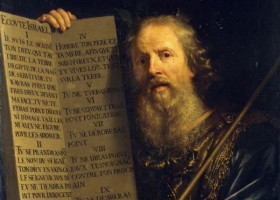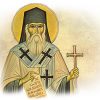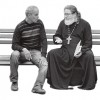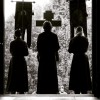In the Name of the Father, the Son, and the Holy Spirit. Amen.
The Hymn (tropar) for today’s saint:
The memory of Thy prophet Moses,
We celebrate today, O Lord.
By his prayers, we beseech Thee,
O Christ God, to save our souls!
Today is the Feast of the Holy and Righteous Moses Prophet and God-seer, as we call him in the Orthodox Church. St. Moses is one of those figures from the Old Testament about whom we think we “know” much, but most of what western Orthodox people know has come to us via that secular Church Father of Hollywood, Cecil B. DeMille, and his famous movie, “The Ten Commandments” (a film that, I understand, is virtually unknown now to the younger generation). DeMille’s film is fine as far as it goes, but once in a while it’s a good idea to check and see what the Church herself has to say about these things, for always the Church’s wisdom, being inspired by the Holy Spirit, is deeper, more accurate and more complete than any secular source, however sincere it may otherwise be.
Let’s begin by looking at what the Prologue of St. Bishop Nikolai Velimirovitch has to say about the Holy Prophet Moses, Who Beheld God:
A great leader and lawgiver of Israel, he was born in Egypt in about 1550 B.C. [or around 3500 years ago]. He spent forty years in Egypt at pharaoh’s court, forty years as a shepherd in meditation on God and the world, and his last forty years he led the people through wilderness to the Promised Land, which he saw but did not enter, having at one time sinned against God. He entered into rest at the age of 120. He appeared from the other world on Tabor at the Lord’s Transfiguration, and, according to testimony of St. John of the Ladder, appeared to the monks of Sinai.
That’s it from the Prologue; short and sweet, but too lean for our purposes this morning.

Holy Prophet Moses the Law-Giver and Seer of God
But on the OCA website for this day we find the following account:
The Holy Prophet and God-Seer Moses was of the tribe of Levi, the son of Abram and Jochabed (Exodus 6:20)…Moses was born in Egypt around 1689 B.C. When Pharaoh ordered all male children of the Hebrew slaves to be killed (Exodus 1:22), Moses’ mother placed him in a basket of papyrus coated with pitch, and set him adrift on the Nile. Pharaoh’s daughter found him and raised him as her own son.
At the age of eighty, Moses fled to Midian, where he spoke to God in the Burning Bush on Mt. Horeb (Exodus 3:2). God chose Moses to lead Hi people from the slavery of Egypt. They crossed the Red Sea as if it were dry land, and for forty years they wandered in the desert.
Arriving in the land of Moab, Moses went to the top of Mt. Nabau, or Nebo (Deuteronomy 32:49), which is called Phasga (Deut. 34:1). There, according to the will of God, he died in 1569 B.C. at the age of 120 without entering the Promised Land…
The holy Prophet Moses performed many miracles during his lifetime, and also after his death. He appeared on Tabor with the Prophet Elias at the Transfiguration of the Lord (August 6).
On the day that St John of the Ladder (March 30) was installed as abbot of Mt. Sinai, the Prophet Moses was seen going around and giving orders to the cooks, stewards, and servants. When the guests had gone and the monks were sitting at table, they wondered what had become of the stranger who had been giving orders. St John said, “Our Lord Moses does nothing strange by serving in the place which belongs to him.”
St. Gregory Palamas, the great 14th century Father of the Church wrote a whole book about St. Moses, called the Life of Moses”, but it is much more than a biography; it is St. Gregory’s explanation of all the mystical elements in the life of Moses, all of the wonderful traditions about him that have been passed down through Judaism to Christianity and to our own day in the Orthodox Church. It is a book well worth reading, and it’s in English and still in print. The longer synaxarion has a more complete entry for the feast of the Holy Prophet Moses, too long for me to quote in its entirety here, but a few excerpts will serve to show how very interesting and important this prophet was.
One day God appeared to Moses, in so far as it is possible for a man to look upon Him. Moses had brought his flocks to the mountain of Sinai when he saw a bush burning with a light brighter than the sun, and yet the bush was not consumed. It this Moses saw foreshadowed the great mystery of our Savior’s virginal Conception and of his coming in the flesh, which has overturned the laws of nature at the same time as preserving them.
This is just one of the mystical elements in the life of Moses. Here is another passage from the same source, which describes the events surrounding the giving of the Ten Commandments to the Prophet:
When he [Moses] had received these heavenly revelations within a darkness brighter than the light of this world, Moses went down the Mountain with the Law graven by God on two tablets of stone. The divine light had streamed into his heart to overflowing, making his countenance shine with a brightness that the people, uninitiated into the mysteries of God, could not bear to look upon, so that Moses had to veil his face when he spoke to them…”
There are a few main points that we should know, understand, and remember about this God seer. First, it is the perennial teaching of the Orthodox Church that the Ten Commandments have not been abrogated or abridged or modified in any slightest way. Each of these commandments is still in force. And added to these are the two new Commandments of love, given by Jesus Christ in the New Testament. It is a shame that sermons on the Ten Commandments are not more commonly heard in our parishes. We live in a country and a culture that is so sunk in depravity and immorality of all kinds, now, that a frequent review of the Commandments is really needed.
Secondly, in the life of St. Moses we a man who was a desperately thirsting before he was a God-Seer. His long sojourn in exile—forty years—in the desert, before God first began to reveal Himself to him, reminds us of the faithful early Desert Fathers of the Christian dispensation. This was four decades of intense ascetical suffering, and it penance endured willingly by Moses for his sin—having killed a man in anger while still in Egypt. By contrast, how much we wince and complain, like spoiled brats, at the inconvenience of a fasting day or season, or the temporary loss of electrical power, and other inconveniences that quite normally and regularly come into our lives. The “inconvenience” and “annoyance” of Moses’ long years of exile in the desolate desert were used by him for purification, first of his sins, then of his passions, so that, in this terrible crucible of heat and suffering, he could be made ready to have his astonishing encounter with the Living God.
And thirdly, we learn that because of God’s revelation of Himself on Mt. Sinai, there could be no images made of God to be worshipped by the Hebrews. They had already been given the bad example of idol-worship during their long sojourn in Egypt, and it was a temptation for them even now, as we learn from the Scriptural account, to resort once again to such heathenism. When Moses asked to see God face to face he was told by the Lord: “No man can see My face and live.” Instead, he tucked Moses into the cleft of a cave and “passed by” the entrance in such a way that Moses could see only —what? We don’t know. Wind? Fire? Storm? We don’t know. But “something.” Not, however, an image of God the Father as an old man with a long white beard, of this we may be sure.
In Exodus (33:11) God “…spake unto Moses face to face, as a man speaketh unto his friend.” The phrase “face to face” is not used here to refer to their physical position in relation to one another, but the intimate nature of the Lord’s discourse with Moses.
In Deuteronomy (34:10) we read that the Lord “knew” Moses “face to face”. Again, the phrase “face to face” is not being used of physical position, but of their relationship. How did the Lord know Moses face to face? The following verses tells us, “In all the signs and the wonders, which the LORD sent him to do in the land of Egypt to Pharaoh, and to all his servants, and to all his land, and in all that mighty hand, and in all the great terror which Moses showed in the sight of all Israel.” (34:11-12).
In fact, however, it is the constant teaching of the Holy Fathers that what Moses encountered on Mt. Sinai was the Lord Jesus Christ Himself, in pre-incarnate state, for God the Father has never at any time made contact with or revealed Himself, except through the Son, And it is the Son who makes the Father known to us. It is only after the incarnation of Christ that it becomes again permissible to make images of Christ God, and the saints and angels, not in order to worship them, as did and do pagans, but as reminder to us of heavenly realities.
Let me close this morning with this verse in honor of the Holy God-Seer Moses.
The Kontakion Hymn for St. Moses:
The company of the prophets rejoices with Moses and Aaron,
For their prophecy is fulfilled
As the Cross by which thou hast saved us shines forth.
Save our souls by their prayers, O Chris
In the Name of the Father and the Son, and the Holy Spirit. Amen.

















